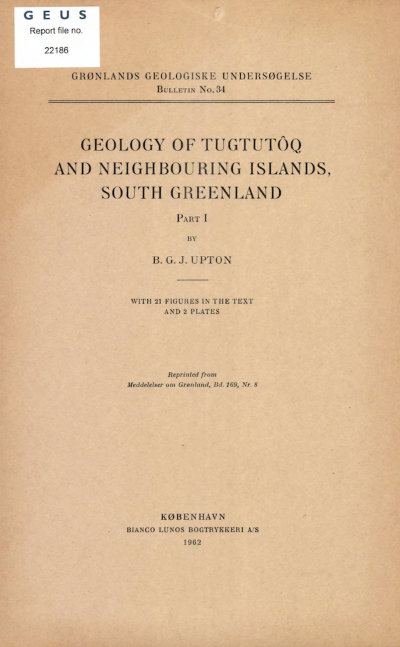Geology of Tugtutôq and neighbouring islands, South Greenland. Part I
DOI:
https://doi.org/10.34194/bullggu.v34.6568Abstract
Tugtutôq is an island lying off the SW. coast of Greenland, separated from the mainland by fjords overlying major lines of faulting. The main island, together with numerous smaller islands and skerries, is largely composed of Precambrian granites formed after the close of the Ketilidian orogeny. At a still later date in the Precambrian alkaline rocks were extensively intruded into the south Greenland region and, of these, a large variety are preserved in the Tugtutôq area. Many of the intrusions take the form of ENE.-WSW. trending dykes running parallel to one of the major faulting directions. Tugtutôq lies along a belt in which these dykes are especially concentrated and provides a rewarding field for their investigation. One of the earliest dykes, some 500 m broad, is composite and consists of narrow gabbroic marginal zones and a broad central component of syenite. The syenite centre changes character along its 20 km outcrop from a nepheline-poor 'augite syenite' to a variety of foyaite. 'Giant-dykes' of troctolitic gabbro, up to 800 m across, were intruded after the solidification of the composite dyke. In certain sectors of the dykes the gabbros display primary layering. These gabbro dykes themselves occasionally show composite character and possess a central zone of quartz syenite or of alkalic gabbo akin to the marginal gabbro of the earlier composite dyke. Small bodies of pyroxenite, related to a larger mass cutting the troctolitic gabbros on the mainland, occur on the main island. Subsequent to these ultramafic intrusions dense swarms of small dykes composed of olivine dolerite, quartz microsyenite, alkali microgranite and hybrid variants were injected through the area. Many of these are also composite. The widespread presence of labradorite anorthosite fragments in the dyke rocks prompts the suggestion that a large body of anorthosite underlies the area. At a late stage in the igneous cycle a ring-complex developed across the main dyke belt and this, in striking contrast to the nearby and roughly contemporaneous Ilímaussaq complex, consists only of saturated syenite and alkali granites. The complex comprises some half-dozen ring-intrusions of related syenites and granites followed by a stock of coarse perthositic syenite. Intrusive activity in the area came to a close with eruption of further dyke swarms and occasional sills.
Downloads
Published
Issue
Section
License
This article is distributed under a CC-BY 4.0 licence, permitting free redistribution and reproduction for any purpose, even commercial, provided proper citation of the original work. Author(s) retain copyright over the article contents.


